
Public Site
| Members only: Restricted Docs Membership Biographies Your Account Your Flights Mailing Lists Badges Board Notes CrossCountry Instructors Logsheets Students Tracking Admin |
Skyline Soaring Club in the Twentieth Century
By Jim Kellett, January, 2000Chapter IV -- Skyline Soaring Club, Getting Started, New Market
On June 15, 1991, the Corporation announced at a special invitational meeting of its clientele the company's decision to terminate business, and its encouragement for a group to form a Club with some of the assets. At that meeting Shane Neitzey volunteered to take the lead in setting up such a group. Over the next few weeks, three of these people - Neitzey, Leyendecker, and Postma - worked diligently to solicit charter members who would put up the initial money, and to start framing the organization of the new club. Without the selfless work of these three people in the summer of 1991, Skyline Soaring Club would have never been born.

By August 13, 1991 Shane had led the first several meetings of the organizational group and they had selected an Acting Board of Directors consisting of James Postma, Leo Meacher, Lonnie Patch, Bill Vickland, and Bob Leyendecker. Lonnie Patch was a regular with WSC, and owned a 1-26 in partnership with Ralph Hendrickson. She was the recognized doyenne of the group, the sparkplug behind most or all of the many social events we had enjoyed at Warrenton. Shortly after the Club was formed, however, Lonnie fell in with the race car crowd, and now lives with a Porsche mechanic in Falls Church.
The group called its first meeting to call for Charter Members on August 24. Of the 40 individuals who had made verbal commitments to invest in the startup of the new club, 23 actually ponied up the money the very first check, for $1300, was from Charles Ray. The first group of Acting Board of Directors was also named officers - Jim Postma, President; Lonnie Patch, Secretary; Bob Leyendecker, Vice President; Bela Gogos; Treasurer; Shane Neitzey; Membership Chief; and Leo Meacher; Operations Chief. (The summer and fall of 1991 were a bit tricky for Annear and myself - as Directors and Officers of the Company, were in the curious position of having to represent the Corporation in the negotiations with Shane's group which was forming the Club that we both intended to join and invest in!)
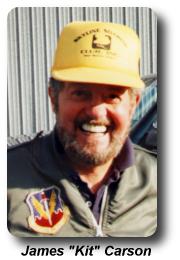
The founding members of Skyline were, myself, Spencer Annear, Shane Neitzey, Dick Ault, Bob Leyendecker, Leo Meacher, Jim Miles, Jim McCulley, Bela Gogos, Bill Wark, Charlie Lee, Fred Winter, Joe Rees, Ralph Popp, Bob Neff , Paul Dawson, Richard Matsko, Phil Jordan, Ray Charles, Ernie Snowden, Wirt Walker, Tom Phillips, Bill Westerman, and Kit Carson. Kit had been towing at WSC for years. One of the relatively few Club members who, fortunately for the Club, likes to fly the towplane more than the gliders, continues to be a regular towpilot even since he retired and moved to Mineral, VA, where is lives with wife Marty. They drive a luxurious motor home, so when he comes to FRR, they just park the home at the end of the hangar and fly all weekend!
Founding member (and long term Treasurer) Bela Gogos learned to fly gliders as a teenager in Hungary. The picture shows him (second from right)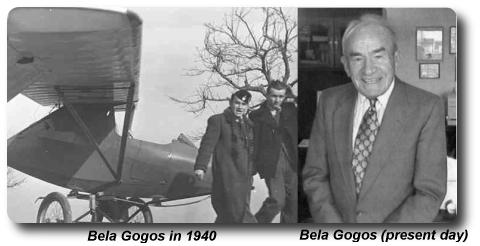 with the Air Academy's trainer in 1940. After the war, in which he flew Me-109s and many other military aircraft in the Luftwaffe, his Russian captors imprisoned him. He survived solitary confinement in the notorious Lubianka prison in Moscow and years of forced labor in a Soviet gulag before moving to Canada, where he met and married Susan, a Hungarian athlete who defected from the Olympic team. They moved again to the United States and raised a family, while having an outstanding career with IBM. He retired from IBM and with his retirement bonus, upgraded his ASW-19 to an ASW-20, which he still flies. In 1998 he personally funded the
Gogos Scholarship program for young pilots, which is managed through the Collegiate Soaring Association. It has already funded several young men and women in several stages of their soaring career, helping Bela to share the passion that has so profoundly affected his personal life to another generation. In 1999, Bela and Susan were prominently featured on the front page of the Winchester Star. The article included excerpts from Bela's autobiography, which is being written as the year comes to a close.
with the Air Academy's trainer in 1940. After the war, in which he flew Me-109s and many other military aircraft in the Luftwaffe, his Russian captors imprisoned him. He survived solitary confinement in the notorious Lubianka prison in Moscow and years of forced labor in a Soviet gulag before moving to Canada, where he met and married Susan, a Hungarian athlete who defected from the Olympic team. They moved again to the United States and raised a family, while having an outstanding career with IBM. He retired from IBM and with his retirement bonus, upgraded his ASW-19 to an ASW-20, which he still flies. In 1998 he personally funded the
Gogos Scholarship program for young pilots, which is managed through the Collegiate Soaring Association. It has already funded several young men and women in several stages of their soaring career, helping Bela to share the passion that has so profoundly affected his personal life to another generation. In 1999, Bela and Susan were prominently featured on the front page of the Winchester Star. The article included excerpts from Bela's autobiography, which is being written as the year comes to a close.
The last newsletter of the Warrenton Soaring Center was published on September 22, 1991 (I was editor of the newsletter.) The first newsletter of the Skyline Soaring Club was published in November, 1991. It reported the raising of some $28,000 from non-interest bearing loans from a group of Charter Members. Most of the money was used to purchase the Pawnee the Club still flies. Skyline's first flight was at Warrenton Airpark, on November 23, 1991.
In the process of selling stuff off, the Company managed to foist the old Concord trailer onto the new Club. It didn't take long for the Club to realize the trailer was useless, so after much fumbling around, we managed to give it to the Salvation Army on July 1,1994. Spencer Annear took on the task of delivering the trailer to the Salvation Army, and on checking the tires for the move, found that two held air and two were rotted out. He had to jack the trailer up, remove the rotted tires, find used tires in Warrenton, have them mounted and, reinstall them. He recalls lying in the grass working on the wheels and getting up to see a herd of wood ticks moving in. When the Army came to pull the trailer to northeast D.C. for the auction, he waited awhile before starting out to see how things were going. Sure enough the truck and trailer were soon stopped by the road. That was a very tender pull up as the trailer was about to fall apart. Spencer went to the auction and saw the trailer sitting there, but did not wait to see it auctioned as there were about 50 cars, on the block, ahead of it. Somebody probably bought it for the frame and wheels as the top was pretty much dry rotted.
James Postma was the Club's first president, but he moved away shortly after it was founded. He was succeeded by Spencer Annear who led the club for the next six years during its critical youth. The Club's third President, Joe Rees, was elected in 1998. The Club's unique structure ? with an all-powerful Board that elects officers - was Annear's brainchild. I recall thinking it was really weird when we first put the Club together, but the concept was exactly right for a soaring club, reflecting the reality of how such Clubs actually get to be managed. A lot of the Club's success is due, in my opinion, to this structure and to the foresight that led to it, plus the consistent fiscal conservatism of Treasurer Bela Gogos. With the fortuitous leadership of these two people, the Club enjoyed managed growth and steady debt reduction, so that the Club will be debt free in the first few months of the year 2000.
By January, 1992, the fledgling Club had survived the purchase of the Pawnee and the 2-33, N2743H. It had also secured the agreement with the owners of the ASK-21 (Fred Winter and Bob Neff) to lease the ship to the Club on similar terms as the lease to WSC. The final acquisition was the lease of the SGS 1-36 from owners Ralph Popp and Joe Rees. (This is the Club fleet that remains as of this writing.) There were 36 members at the end of January.
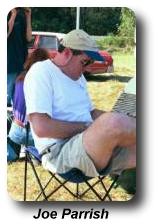
From the very beginning, the Club wrestled with the very same fundamental issues that had wracked all its predecessor organizations - shall it be primarily a training club? How much and what kind of equipment should it own? Where will it fly? How large should the membership be? Should we invest in public service activities (e.g., supporting the training of young people)? The early Board was influenced by the Club's origins in the Warrenton Soaring Center, which is partly responsible for today's emphasis on training. There was (and still remains) serious concern by the Club's leaders that the Club should not compete with commercial soaring FBOs, nor should it engage in any activity that threatens even slightly the Club's non-profit status (for compliance with applicable insurance, tax, and CFR requirements.) Still, training is a major component of the Club's activities as we enter the 21st century, as attested to by the baptism of still another member's first solo shown here (right)! Joe Parrish (left), one of the Club's currently active instructors, got his CFI(G) at a commercial gliderport in 1994 and soon became one of the Club's more active pilots. Shown here working on a lesson plan for a student, he now flies an LS-4.
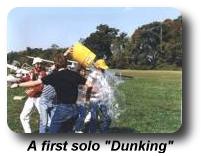
Scheduled operations began at FRR in March, but by the end of April, the Board approved a move to New Market Airport (8W2). There were several reasons for the move; one was the presence of some really obnoxious skydivers at FRR at the time, and the other was a lack of hangar space. (It's worth noting that shortly after the Club moved to 8W2, the skydivers crashed both their jump planes!) The founders of the Club were keenly aware of the importance of hangars, having lost thousands of dollars to maintaining both gliders and towplanes due to the effects of weather on tied-out aircraft. Kevin Fleet and I, using his computerized surveying equipment and several hundred pounds of fertilizer, marked 8W2 so that no overflying pilot would fail to know WE WERE THERE! (This picture was published in Soaring magazine.)

The New Market Airport has a history of its own that deserves some research that is beyond the scope of this work. When the Club moved there, it was owned and managed by one Ed Raney who lived on the airport property with his wife Linda and their two small children. To get right to the point, many people (such as myself) found his personality excessively abrasive. Ed's behavior caused the Club to lose several members - including myself (in the summer of 1992) Dick Ault, Bill Jones, and others. His unpredictable behavior was unsettling, to say the least, and I was (and still am) fearful for my safety around him.
Ed was convicted of tax fraud in 1995 and imprisoned. He escaped in 1997 but was returned to a prison somewhat more secure than the one from which he escaped. He is scheduled for release March 24, 2000.
But 8W2 had hangars! Not very fancy ones, but certainly affordable. And the Club benefited mightily from the fortunate circumstance that our Leo Meacher hit it off with Ed Raney. It was this relationship that enabled the Club to move there in the first place, and Leo's running interference with Ed made flying there palatable for the rest of the Club.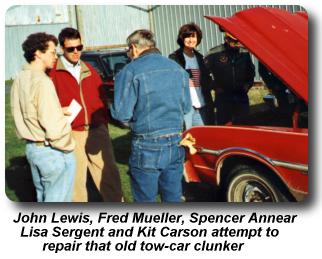
We even had a club car - an old clunker that Ed Raney had actually given the Club. We managed to get it running (you had to stick your finger in the hole where the ignition key was supposed to be fitted, feel for a peg, and push it hard to crank the thing!). Here, Skyliners John Lewis, Fred Mueller, Spencer Annear, Lisa Sergent, and Kit Carson ponder the next step(s) on one of its more recalcitrant days.
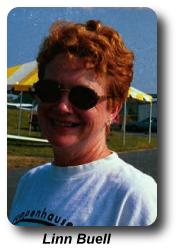
Linn Buell, CFI(G) and towpilot, was one of the people who made weekday operations possible starting in 1997. (Linn flies an LS-4 in Florida (where she now lives) and a 1-26 in Germany.) While a member of Skyline, Linn was named Chair of the Board of Directors of the National Soaring Museum, and served as President of the Vintage Sailplane Association. Linn was one of the very active towpilots (along with Jim McCulley, Fred Daams, and others) who made weekday operations possible.) Weekday flying made a big difference in the speed with which members learned to fly and triggered a sharp increase in Club income.
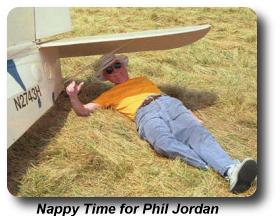 Phil Jordan continued his artistic contributions to the Club by serving as the Editor of the Club's newsletter, SKYLINES, was and is also a big fan of the Club's two seater "Miss Daisy" (the SGS 2-33). While he also owns a share in a syndicated 1-26, you can often find Phil showing his affection for Miss Daisy, as you can see here (although this picture was taken before Bill Vickland performed a terrific restoration, in 1999.)
Phil Jordan continued his artistic contributions to the Club by serving as the Editor of the Club's newsletter, SKYLINES, was and is also a big fan of the Club's two seater "Miss Daisy" (the SGS 2-33). While he also owns a share in a syndicated 1-26, you can often find Phil showing his affection for Miss Daisy, as you can see here (although this picture was taken before Bill Vickland performed a terrific restoration, in 1999.)
When Raney went to jail in the summer of 1995, I moved back to 8W2 (I'd been flying my Cirrus at Scott Airpark). The Club began to really thrive in his absence (although we'd also lost Leo, who moved to New Mexico). We rented a total of five hangars, and kept all the Club gliders plus four member-owned gliders in them. The field was superb for gliders ? sod and paved runways, in easy gliding distance to a fine ridge, and with fuel on field. Just a few of the highlights of the 1995 - 1998 period include:
- Shane Neitzey became, on May 12, 1996, the first Skyline Club member to complete his diamond badge at 8W2.
- The Club's website was started in 1995 by a group of talented "webweenies" (Piet Barber, Dave Weaver, Richard Freytag, and Joe Parrish).
- The web quickly led to worldwide recognition, and marked the beginning of a regular stream of visiting Temporary Members from foreign countries.
- Membership grew from 39 at the end of 1994 to 62 by the end of 1999.
- The number of launches jumped dramatically in 1997, coincident with the beginning of weekday operations, from 756 the year before to over a thousand. (It's continued to grow, to 1,597 by the end of 1999.)
- The first "new"member- owned glider, a 1-26, was bought by Tim James and Lisa Sergent. (The only other member-owned gliders at that time had been purchased before the respective owners joined the Club.)
- The club hosted two DuPont Regattas at New Market, attracting participants from several area clubs.
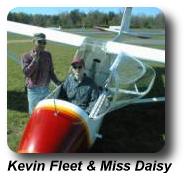
Kevin Fleet is currently one of the Club's Directors. He came to Skyline as a hang glider pilot with over a thousand flights. He soon came to like the fact that this was soaring in a machine in which his body was not a structural component, and stuck with it. He now is co-owner (with Joe Rees) of the SGS 1-36 that is leased to the Club. He's shown here getting ready to give his daughter a spin in the recently refurbished Miss Daisy.
While Ed Raney was in jail, Linda divorced him and managed the airport, with the help of a couple of hired receptionists and a close friend, Ken Painter. One side effect of Raney's conviction was that large parts of his real estate holdings - including the airport - were to be sold off. The Club vigorously pursued finding a "sugar daddy" to buy the airport, but to no avail. The asking price was always far in excess of any reasonable estimate of the value of the property. In the end (in 1998), we learned that Linda had been able to sell off enough other holdings that she could retain ownership of the airport.
The Club worked well (we thought) with Linda, and we played a significant role in helping the airport get approval for State funding and with other issues. With the conclusion that she would continue ownership, we perceived that we "had it made" since we'd been quite active in helping her keep afloat for the several years that process took. It was, therefore, a considerable shock when she announced in the fall of 1998 that the Club would not be allowed to operate there in 1999. The alleged reason was our use of an "unapproved" runway (the sod), since it doesn't meet the FAA required minimum distance of 500 feet between centerlines of parallel runways. Personally, I think we were blindsided by a small-p political issue that we weren't clever enough to avert ? to the best of my knowledge, there was never any dialog with the FAA or the State on this subject, so we'll never know if there was room for compromise with the government agencies.
| Foreword, Acknowledgements, Introduction & Overview | Chapter I The Beginnings |
Chapter II Capitol Area Soaring School |
Chapter III Warrenton Soaring Center |
Chapter IV Skyline Soaring Club, New Market |
Chapter V Skyline Soaring Club, Front Royal |